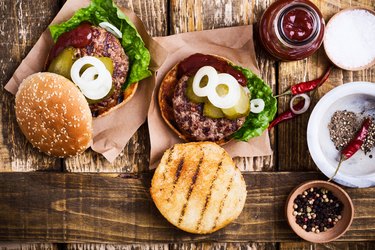
When you're grilling up some nice, juicy burgers for a cookout or family dinner, it's worth considering the best way to keep hamburgers warm. Following proper food safety guidelines can make the difference between an enjoyable meal and a foodborne illness from eating tainted food.
How to Make Crock-Pot Hamburgers
Video of the Day
Keeping your just-grilled hamburgers warm helps to preserve the burgers' flavor and moisture content. For tasty Crock-Pot hamburgers, follow a few simple steps.
Video of the Day
- Transfer your grilled hamburgers: Place your hot grilled hamburgers in a Crock-Pot. Place the glass cover on the cooker, advises the Cooperative Extension.
- Set the temperature: Turn the Crock-Pot to the 140 degrees Fahrenheit "Warm" setting. Avoid the "Low" and "High" settings, as those temperatures could keep cooking and drying out the Crock-Pot hamburgers. The burgers will still dry slightly on the "Warm" setting.
- Add an oven-safe bowl: To warm your Crock-Pot hamburgers for more than an hour, place an oven-safe bowl at the bottom of the slow cooker.
- Fill the bowl with water: Add water, which will produce steam that keeps the burgers moist. Note: Don't use this method to warm the Crock-Pot hamburgers for an extended time period.
If you'd like to leave your Crock-Pot running while you're out, you can program the device to cook while you're at home, even while you're sleeping at night, suggests PennState Extension.
Warning
If you have an older slow cooker without a "Warm" setting, don't attempt to use this method to keep hamburgers warm.
Follow This Burger Bath Recipe
To keep your just-grilled burgers, brats or chicken warm, you can also try a burger bath, suggests Mississippi State University Extension. This simple, easy technique should add welcome flavor and moisture to your burgers.
- Fill a grill-safe pan: Fill a pan with beer, broth, juice or other flavorful liquid.
- Add your grilled burgers: After cooking, add your grilled meat to the burger bath.
- Heat the pan safely: Place the pan on the grill away from direct heat. The meat will stay warm and moist, and the liquid will add some extra zing.
So, how can you be absolutely sure your hamburgers, brats, chicken or other foods are completely cooked? As the Academy of Nutrition and Dietetics states, cooked food must reach an internal temperature high enough to kill dangerous bacteria. When that occurs, the food is safe to eat.
To confirm that the food has reached the target temperature, test it with a properly calibrated food thermometer. Don't rely on your senses to make this important food safety decision.
Tip
You can also try keeping hamburgers warm in a chafing dish.
Cool Down Food Safely
If you've cooked up a pot of hearty soup or chili, or baked a delicious casserole, you might have some left over. Can you safely put the remaining food in the refrigerator? The Michigan State University Extension says yes, as long as you follow some guidelines.
First, don't place the large container of just-cooked food in the refrigerator or freezer. The hot food can elevate the temperature of the appliance and the food stored inside it, so wait for it to cool down first. By safely cooling your food within two hours, you'll fend off harmful foodborne bacteria, states the USDA Food Safety and Inspection Service. These organisms thrive in temperatures ranging from 40 to 140 F (also called the "danger zone").
When you're ready to enjoy some tasty leftovers, reheat them in a conventional or microwave oven, or use the stove top, stresses the Mayo Clinic. Ensure that the food's internal temperature reaches 165 F.
Never use a slow cooker for reheating food. A slow cooker doesn't generate enough heat to kill dangerous foodborne bacteria.
- Cooperative Extension: "Ask an Expert: Can I Keep Grilled Hamburgers Warm in Crock Pot?"
- PennState Extension: "The Benefits of Slow Cooker Meals"
- Mississippi State University Extension: "Food Safety at Barbecues and Picnics"
- Academy of Nutrition and Dietetics: "10 Common Food Safety Mistakes"
- Michigan State University Extension: "Cooling Hot Food, Do It Right to Prevent Bacterial Growth"
- USDA Food Safety and Inspection Service: "Danger Zone: (40°F - 140°F)"
- Mayo Clinic: "How Long Can You Safely Keep Leftovers in the Refrigerator?"
- University of Rhode Island: "Causes and Prevention of Foodborne Illness"